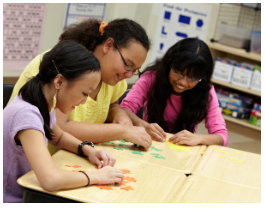By: Margo Ensz on June 16th, 2014
Visual Learning Technology & Differentiated Instruction
Featured Topics: Differentiated Instruction | Featured Topics: Professional Development
Any teacher will tell you that you never have a classroom filled with students who learn the same way, so expecting them to is setting them up for failure. Differentiated instruction is all about customizing instruction, which can be difficult and daunting for teachers who are facing new challenges, standards, and expectations. While differentiating instruction may seem like a no-brainer for educators, teachers and principals must make the connection between technological tools and differentiated instruction in order to successfully integrate this practice into their schools and classrooms.
 Visual learning technology allows teachers to not only tailor instruction but also customize content for specific lessons. When visuals are customized specifically for the content being taught, teachers have the flexibility to meet the needs of all learners, whether visual-spatial, kinesthetic, etc. However, creating all of these visuals tailored to curriculum can be extremely time-consuming. Visual learning technology like VariQuest Visual Learning Tools allows teachers to diversify instruction on the spot, as the technology is in-house and specifically designed for educational visuals.
Visual learning technology allows teachers to not only tailor instruction but also customize content for specific lessons. When visuals are customized specifically for the content being taught, teachers have the flexibility to meet the needs of all learners, whether visual-spatial, kinesthetic, etc. However, creating all of these visuals tailored to curriculum can be extremely time-consuming. Visual learning technology like VariQuest Visual Learning Tools allows teachers to diversify instruction on the spot, as the technology is in-house and specifically designed for educational visuals.
Technology in the classroom does not necessarily mean an iPad at every desk and a Smart Board on every wall. The technology of our tools is not omnipresent in the classroom—if students are not the ones actually using the tools, the technology will not affect their classroom time distractingly in any way. Schools employing multiple types of technology allow for multiple levels of classroom environment and therefore student engagement. VariQuest Visual Learning Tools create classroom environments that reinforce concepts continually over time.
Anchor charts, poster-size graphic organizers, and mind maps, for example, encourage group work and positive interactions; cutouts and manipulatives can be used for educational displays and for hands-on activities, and award plaques and stickers recognize the high achievements and cooperative behavior of students. By differentiating instruction in these ways, teachers can help improve classroom management, creating a better learning environment for every student.
Visual learning tools can be used to:
 Create interactive learning centers – Create an interactive learning environment with differentiated instructional tools to improve student achievement for visual, tactile, and kinesthetic learners
Create interactive learning centers – Create an interactive learning environment with differentiated instructional tools to improve student achievement for visual, tactile, and kinesthetic learners- Support visual and kinesthetic learners – Create a print-rich learning environment with static visuals and tangible study aids to reinforce key concepts, enhance knowledge acquisition and retention, and promote positive behavior
- Differentiate lessons and assessments – Tailor instruction and offer opportunities for students to demonstrate their knowledge and abilities in non-traditional, visual ways by customizing content and including visual representations in lessons
- Provide project-based learning experiences – Incorporate posters and manipulatives into interactive learning centers to engage visual and kinesthetic learners, while helping students of all abilities work together and contribute at their individual skill level
Visual learning technology is a valuable investment for districts, as this avenue for differentiated instruction is important across disciplines and age groups.
- Primary: Motivation and good learning habits are established at a young age, so it is important to engage students early on. With visual learning tools, you can easily create an interactive classroom through the use of visuals that captivate your students, support early instruction across all disciplines, and meet the unique needs of individual learning styles.
 Intermediate & Secondary: The right resources and developmentally appropriate strategies can bring stability and consistency to a transitional period of life. VariQuest Visual Learning Tools give you the ability to quickly and easily create engaging visual aids using content that can be customized to meet the wide range of skills, interests and developing rates of adolescents.
Intermediate & Secondary: The right resources and developmentally appropriate strategies can bring stability and consistency to a transitional period of life. VariQuest Visual Learning Tools give you the ability to quickly and easily create engaging visual aids using content that can be customized to meet the wide range of skills, interests and developing rates of adolescents.- English Language Learners: When teaching across languages, visual and kinesthetic learning becomes even more important. Use visual learning technology to create graphic organizers, maps, and large-scale reading & editing activities. Visual learning tools also work great for providing ELL students with hands-on manipulatives for storytelling and vocabulary lessons, and large-scale bulletin board displays like letter and world walls.
Just as there are many approaches to learning, there are many approaches to differentiating instruction. In an increasingly visual age, technology that supports visual learning will be instrumental in the efficiency and effectiveness of teachers. 
